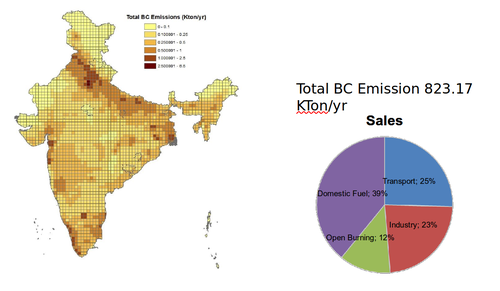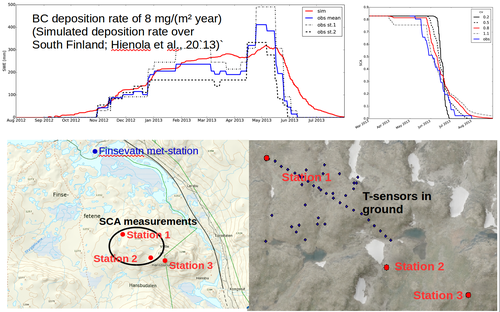HyCAMP: Hydrologic Sensitivity to Cryosphere-Aerosol interaction in Mountain Processes
The HyCAMP project conducted a series of activities designed to raise the current level of understanding regarding the hydrologic sensitivity in the Hindu Kush, Karakoram and Himalayan (HKKH) mountain system to interaction between aerosols and the cryosphere and provided import new insight to extend that knowledge. New sources of data were developed regarding the emissions of black carbon from India, a new algorithm to incorporate aerosol deposition directly to hydrologic modeling was implemented and evaluated in both Norway and India, and several other activities were conducted related to improved understanding and simulation of cryosphere processes, with an emphasis on impacts to hydrology. Water resources are central to Norway's renewable energy market. Aerosol sources for Norway are predominantly remote, so the emphasis on the Norwegian side of the study has been to examine the sensitivity of the hydrologic systems to aerosol interaction, and understand how these processes may impact hydropower forecasting.
About HyCAMP
Our activities are focused on the following:
- Understanding emissions sources of black carbon in India the remote sources for Norway
- Renewable Energy and hydropower forecasting and the impacts of aersols to the cryosphere
- A central outcome of HyCAMP is to further our capacity of hydrologic forecasting for water resources management.
- The ultimate goal of the research is to provide an improved capacity to model hydrological response in glacial and mountain environments to improve predictive capabilities for hydrology.
Objectives
A goal in this project is to explore the impact on hydrological response and water resources forecasting on the interaction between SLCF aerosols and frozen water storage. In this investigation we will conduct model investigations to address deficiencies in the state of knowledge regarding the hydrologic sensitivity to cryosphere-aerosol interaction over the Himalaya and in Norway.
The following objectives are central to this activity:
- Create a strategic partnership between the Indian Institute of Technology and Norwegian Institute for Air Research.
- Establish a bilateral expertise on cryosphere-aerosol impact on water Resources.
- Identify aerosol source regions impacting Himalayan hydrology and develop a priority Matrix for air pollution mitigation yielding the maximum hydrologic benefit.
- Develop a strategy to integrate aerosol forecast prediction into hydrologic modeling.
Outcomes
Black Carbon Emission Inventory for India:
 The HyCAMP project recently generate a new
dataset and first-of-kind ground up emission inventory of black
carbon(BC) for India. The dataset is available through request by
contacting John Burkhart . More information may be found in:
The HyCAMP project recently generate a new
dataset and first-of-kind ground up emission inventory of black
carbon(BC) for India. The dataset is available through request by
contacting John Burkhart . More information may be found in:
Paliwal, U., Sharma, M., and Burkhart, J. F.: Monthly and Spatially Resolved Black Carbon Emission Inventory of India: Uncertainty Analyses, Atmos. Chem. Phys., doi:10.5194/acp-2015-978, 2016.
Hydrologic Response of Aerosol Deposition:
Using the hydrologic model, Shyft, we are
implementing a new snow module which incorporates the response of
aerosol deposition and allows for aerosol deposition fields to be used
as a forcing variable. We have shown that even low concentrations of
black carbon found in the arctic have an impact on the hydrologic
response of snow covered catchments.
In the figure to the right, we show the simulated snow covered areay (SCA) and snow cover fraction (SCF) with simulations accounting for and excluding aerosol deposition. The bottom panels are from a study providing snow cover fraction information through the use of distributed temperature sensors. For more information see:
Gisnås, K., Westermann, S., Schuler, T. V., Litherland, T., Isaksen, K., Boike, J., and Etzelmüller, B.: A statistical approach to represent small-scale variability of permafrost temperatures due to snow cover, The Cryosphere, 8, 2063-2074, https://doi.org/10.5194/tc-8-2063-2014, 2014.
Matt, F. N., Burkhart, J. F., and Pietikäinen, J.-P.: Modelling hydrologic impacts of light absorbing aerosol deposition on snow at the catchment scale, Hydrol. Earth Syst. Sci., 22, 179-201, https://doi.org/10.5194/hess-22-179-2018, 2018.
Financing
A cooperative research project of the The Norwegian Research Council’s MILJØ2015 program (#222195) and The Department of Science and Technology, Government of India through Grant no. INT/NOR/RCN/P-05/2013.
Cooperation
- Department of Geosciences, University of Oslo, Norway
- The Department of Science and Technology, India
